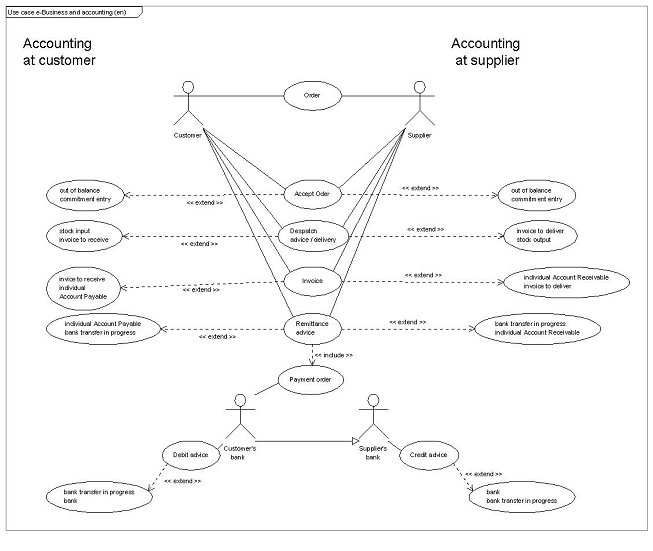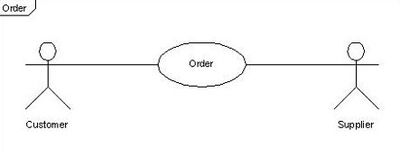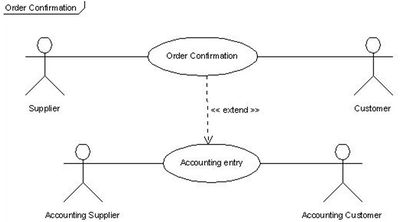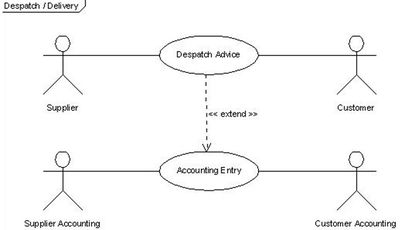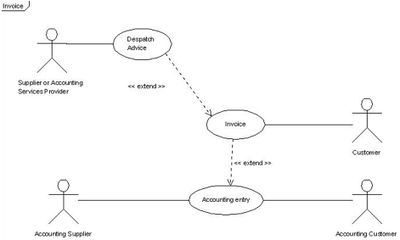Business process elaboration – Order to payment : Différence entre versions
| Ligne 966 : | Ligne 966 : | ||
<p class=MsoToc1><b><span lang=EN-US>Business process name</span></b></p> | <p class=MsoToc1><b><span lang=EN-US>Business process name</span></b></p> | ||
</td> | </td> | ||
| − | <td width= | + | <td width=510 style='width:382.75pt;border:solid windowtext 1.0pt;border-left: |
none;padding:0cm 5.4pt 0cm 5.4pt'> | none;padding:0cm 5.4pt 0cm 5.4pt'> | ||
<p class=MsoHeader><span lang=EN-GB style='font-size:10.0pt;font-family:"Arial","sans-serif"'>Accounting | <p class=MsoHeader><span lang=EN-GB style='font-size:10.0pt;font-family:"Arial","sans-serif"'>Accounting | ||
| Ligne 978 : | Ligne 978 : | ||
"Arial","sans-serif"'>Identifier</span></b></p> | "Arial","sans-serif"'>Identifier</span></b></p> | ||
</td> | </td> | ||
| − | <td width= | + | <td width=510 style='width:382.75pt;border-top:none;border-left:none; |
border-bottom:solid windowtext 1.0pt;border-right:solid windowtext 1.0pt; | border-bottom:solid windowtext 1.0pt;border-right:solid windowtext 1.0pt; | ||
padding:0cm 5.4pt 0cm 5.4pt'> | padding:0cm 5.4pt 0cm 5.4pt'> | ||
| Ligne 991 : | Ligne 991 : | ||
"Arial","sans-serif"'>Actors</span></b></p> | "Arial","sans-serif"'>Actors</span></b></p> | ||
</td> | </td> | ||
| − | <td width= | + | <td width=510 style='width:382.75pt;border-top:none;border-left:none; |
border-bottom:solid windowtext 1.0pt;border-right:solid windowtext 1.0pt; | border-bottom:solid windowtext 1.0pt;border-right:solid windowtext 1.0pt; | ||
padding:0cm 5.4pt 0cm 5.4pt'> | padding:0cm 5.4pt 0cm 5.4pt'> | ||
| Ligne 1 003 : | Ligne 1 003 : | ||
"Arial","sans-serif"'>Description</span></b></p> | "Arial","sans-serif"'>Description</span></b></p> | ||
</td> | </td> | ||
| − | <td width= | + | <td width=510 style='width:382.75pt;border-top:none;border-left:none; |
border-bottom:solid windowtext 1.0pt;border-right:solid windowtext 1.0pt; | border-bottom:solid windowtext 1.0pt;border-right:solid windowtext 1.0pt; | ||
padding:0cm 5.4pt 0cm 5.4pt'> | padding:0cm 5.4pt 0cm 5.4pt'> | ||
| Ligne 1 026 : | Ligne 1 026 : | ||
"Arial","sans-serif"'>Pre-condition</span></b></p> | "Arial","sans-serif"'>Pre-condition</span></b></p> | ||
</td> | </td> | ||
| − | <td width= | + | <td width=510 style='width:382.75pt;border-top:none;border-left:none; |
border-bottom:solid windowtext 1.0pt;border-right:solid windowtext 1.0pt; | border-bottom:solid windowtext 1.0pt;border-right:solid windowtext 1.0pt; | ||
padding:0cm 5.4pt 0cm 5.4pt'> | padding:0cm 5.4pt 0cm 5.4pt'> | ||
| Ligne 1 041 : | Ligne 1 041 : | ||
"Arial","sans-serif"'>Post-conditions</span></b></p> | "Arial","sans-serif"'>Post-conditions</span></b></p> | ||
</td> | </td> | ||
| − | <td width= | + | <td width=510 style='width:382.75pt;border-top:none;border-left:none; |
border-bottom:solid windowtext 1.0pt;border-right:solid windowtext 1.0pt; | border-bottom:solid windowtext 1.0pt;border-right:solid windowtext 1.0pt; | ||
padding:0cm 5.4pt 0cm 5.4pt'> | padding:0cm 5.4pt 0cm 5.4pt'> | ||
| Ligne 1 054 : | Ligne 1 054 : | ||
"Arial","sans-serif"'>Scenario</span></b></p> | "Arial","sans-serif"'>Scenario</span></b></p> | ||
</td> | </td> | ||
| − | <td width= | + | <td width=510 style='width:382.75pt;border-top:none;border-left:none; |
border-bottom:solid windowtext 1.0pt;border-right:solid windowtext 1.0pt; | border-bottom:solid windowtext 1.0pt;border-right:solid windowtext 1.0pt; | ||
padding:0cm 5.4pt 0cm 5.4pt'> | padding:0cm 5.4pt 0cm 5.4pt'> | ||
| Ligne 1 071 : | Ligne 1 071 : | ||
"Arial","sans-serif"'>Remarks</span></b></p> | "Arial","sans-serif"'>Remarks</span></b></p> | ||
</td> | </td> | ||
| − | <td width= | + | <td width=510 style='width:382.75pt;border-top:none;border-left:none; |
border-bottom:solid windowtext 1.0pt;border-right:solid windowtext 1.0pt; | border-bottom:solid windowtext 1.0pt;border-right:solid windowtext 1.0pt; | ||
padding:0cm 5.4pt 0cm 5.4pt'> | padding:0cm 5.4pt 0cm 5.4pt'> | ||
Version du 28 juillet 2011 à 10:00
Sommaire
- 1 Scope
- 2 Principles
- 2.1 Use case: From Accounting Token into Order to Accounting Token into Payment
- 2.2 Use case description – Accounting Token into the Order
- 2.3 Use case description – Accounting Token into the Order confirmation
- 2.4 Use case description – Accounting Token into the Despatch Advice
- 2.5 Use case description – Accounting Token into the Normal invoice
- 2.6 Use case description – Accounting Token into the Self Billing invoice
Scope
The process describes how customer and supplier can provide Accounting Token elements to enable automated generation of accounting entry from the e-document is used at each step in the supply chain.
Principles
From the earliest step, which is the Order from the customer, and the Order Confirmation of the supplier, the Accounting Token is encapsulated in each business documents.
The Order Confirmation is the required starting point of the Order process for the generation of the accounting entry, coherent with generally admitted accounting principles (GAAP).
Thus, an Order Change must always be followed by an Order Confirmation to allow the correct generation of the accounting entry reflecting the confirmed Order Change.
Use case: From Accounting Token into Order to Accounting Token into Payment
The use case shows when accounting and which accounts may be concerned at both trading partners
Use case description – Accounting Token into the Order
|
Identifier |
From Order Process to Payment Process |
|
Actors |
Customer |
|
Description |
To provide at the ordering process the Accounting Token information of the customer needed to support accounting entries generation during the chosen steps of the supply chain process. |
|
Pre-condition |
Parties agreed to provide the Accounting Token information. |
|
Post-conditions |
The next step in the sequence to be considered for accounting entry generation must be a confirmation of the order. |
|
Scenario |
With respect to accounting principles applied accounting entry is created to record commitment into “out of balance accounts” and / or budgetary accounts. |
|
Remarks |
Considering the
current general practice, SME’s do not record this kind of commitment. |
|
Business process name |
Accounting Token into the Order |
|
Identifier |
From Order Process to Payment Process |
|
Actors |
Supplier |
|
Description |
At the ordering process the supplier receives the Accounting Token information of the customer needed to support accounting entries generation. It is expected that the supplier sends it back during the chosen steps of the supply chain process. |
|
Pre-condition |
Parties agreed to provide the Accounting Token information. |
|
Post-conditions |
The Accounting Token received from the customer is stored to be (re-)sent to the customer when needed. |
|
Scenario |
|
|
Remarks |
No influence on supplier’s accounting figures; From supplier’s accounting view, the next step in the sequence to consider for accounting entry generation must be the Order Confirmation which means a firm commitment to provide the services or goods. |
Use case description – Accounting Token into the Order confirmation
|
Business process name |
Accounting Token into the Order confirmation. |
|
Identifier |
From Order Process to Payment Process. |
|
Actors |
Supplier |
|
Description |
The Order Confirmation contains the Accounting Token information of the customer. It possibly provides the Accounting Token information of the supplier needed to support accounting entries generation at this step supply chain process. |
|
Pre-condition |
Customer’s Accounting Token has been included into the Order message and given back. Parties agreed to provide the Accounting Token information. |
|
Post-conditions |
The value of each line and the total value of the order confirmation must be provided on the order confirmation. |
|
Scenario |
The order confirmation acts the commitment of both parties. Accounting entry possibly occurs to record commitment into “out of balance accounts” and / or budgetary accounts into accounting accounts of the supplier and those of the customer. The Accounting Token of the supplier is needed when accounting books are kept outside of the entity, e.g. at an external accounting firm. |
|
Remarks |
Considering the current general practice, SME’s do not often record commitment. Implementing accounting entries from this step onward shall translate a better view of the reality in the accounts. Future web services will enable to stick business steps figures with account’s ones and consequently improve the fairness, accurateness and timeliness of accounting books. |
|
Business process name |
Accounting Token into the Order confirmation |
|
Identifier |
From Order Process to Payment Process |
|
Actors |
Customer |
|
Description |
The Order Confirmation gives back the Accounting Token of the customer. |
|
Pre-condition |
Customer’s Accounting Token was included into the Order. Customer’s Accounting Token is reproduced without change on the Order Confirmation. The value of each line and the total value of the order confirmation must be provided on the order confirmation. |
|
Post-conditions |
Accounting entry to be generated by an appropriate software tool. |
|
Scenario |
To book commitment into “out of balance accounts” and / or budgetary accounts. |
|
Remarks |
Considering the current general practice, SME’s do not often record commitment. Implementing accounting entries from this step onward shall translate a better view of the reality in the accounts. Future web services will enable to stick business steps figures with account’s ones and consequently improve the fairness, accurateness and timeliness of accounting books. |
Use case description – Accounting Token into the Despatch Advice
|
Business process name |
Accounting Token into the Despatch Advice |
|
Identifier |
From Order Process to Payment Process. |
|
Actors |
Supplier. |
|
Description |
The supplier confirms despatch quantities of ordered goods and possibly acts stock outflow. The Despatch Advice contains the Accounting Token information of the customer. It possibly provides the Accounting Token information of the supplier needed to support accounting entries generation at this step supply chain process. |
|
Pre-condition |
Customer’s Accounting Token has been included into the Order message and given back. Parties agreed to provide the Accounting Token information. The value of each line and the total value of the order confirmation must be provided on the order confirmation. |
|
Post-conditions |
At supplier’s accounting side, accounting entry to be possibly generated by an appropriate software tool. |
|
Scenario |
a) Stock outflow entry to be booked with a counterpart “invoice to prepare”. b) In case commitment “out of balance accounts” and / or budgetary accounts was recorded, the [complete or partial] fulfilment of the commitment is acted by reversing [totally or partially] the original entry. |
|
Remarks |
|
|
Business process name |
Accounting Token into the Despatch Advice |
|
Identifier |
From Order Process to Payment Process |
|
Actors |
Customer |
|
Description |
The Despatch Advice of quantities acts the transfer of responsibility on the delivered goods. This must be translated into accounting entries. The Despatch Advice contains the Accounting Token information of the customer. |
|
Pre-condition |
Customer’s Accounting Token was included into the Order. Customer’s Accounting Token is reproduced without change on the Despatch Advice. The value of each line and the total value of the order confirmation must be provided on the Despatch Advice. |
|
Post-conditions |
Accounting entry to be generated by an appropriate software tool. |
|
Scenario |
a) Stock inflow entry to be booked with a counterpart “invoice to receive”. b) In case commitment “out of balance accounts” and / or budgetary accounts was recorded, the [complete or partial] fulfilment of the commitment is acted by reversing [totally or partially] the original entry; |
|
Remarks |
|
Use case description – Accounting Token into the Normal invoice
|
Business process name |
Accounting Token into the Normal Invoice |
|
Identifier |
From Order Process to Payment Process |
|
Actors |
Supplier |
|
Description |
The supplier produces the invoice on basis of the despatch quantities of products or services. This invoice must be translated into accounting entries and conform to fiscal requirements. The Invoice contains the Accounting Token information of the customer. It possibly provides the Accounting Token information of the supplier needed to support accounting entries generation at this step supply chain process. |
|
Pre-condition |
Customer’s Accounting Token has been included into the Order message and given back. Parties agreed to provide the Accounting Token information. The value of each line and the total value must be provided on the invoice. |
|
Post-conditions |
At supplier’s accounting side, accounting entry to be possibly generated by an appropriate software tool. |
|
Scenario |
Invoice can be produced either by the supplier or by a service provider on basis of despatch advices where values have been calculated in advance. In supplier’s accounting books, “Invoice to produce” to be balanced with individual account receivable. |
|
Remarks |
|
|
Business process name |
Accounting Token into the Normal Invoice |
|
Identifier |
From Order Process to Payment Process |
|
Actors |
Customer |
|
Description |
The customer receives the invoice on basis of the despatch quantities of products or services. This invoice must be translated into accounting entries and conform to fiscal requirements. The Invoice contains the Accounting Token information of the customer. |
|
Pre-condition |
Customer’s Accounting Token is reproduced without change on Invoice |
|
Post-conditions |
Invoice is validated and approved by the right authority. Accounting entry to be generated by an appropriate software tool. |
|
Scenario |
Invoice can be produced either by the supplier or by a service provider on basis of despatch advices where values have been calculated in advance. In customer’s accounting books, “Invoice to receive” to be balanced with individual account payable. |
|
Remarks |
|
Use case description – Accounting Token into the Self Billing invoice
|
Business process name |
Accounting Token into the Self billing Invoice |
|
Identifier |
From Order Process to Payment Process |
|
Actors |
Customer |
|
Description |
The customer produces the invoice on basis of quantities received of products or services. This invoice must be translated into accounting entries and conform to fiscal requirements. The Invoice contains the Accounting Token information of the customer. It possibly provides the Accounting Token information of the supplier needed to support accounting entries generation at this step supply chain process. |
|
Pre-condition |
Customer’s Accounting Token is reproduced without change on Invoice Supplier’s Accounting Token is possibly reproduced without change on the Invoice. |
|
Post-conditions |
Accounting entry to be generated by an appropriate software tool. |
|
Scenario |
Invoice can be produced either by the customer or by a service provider on basis of despatch advices where values have been calculated in advance. In customer’s accounting books, “Invoice to receive” to be balanced with individual account payable. |
|
Remarks |
|
|
Business process name |
Accounting Token into the Self billing Invoice |
|
Identifier |
From Order Process to Payment Process |
|
Actors |
Supplier |
|
Description |
The supplier receives the invoice on basis of the despatch quantities of products or services. This invoice must be translated into accounting entries and conform to fiscal requirements. The Invoice possibly contains the Accounting Token information of the supplier. |
|
Pre-condition |
Supplier’s Accounting Token is possibly reproduced without change on the Invoice. |
|
Post-conditions |
Accounting entry to be generated by an appropriate software tool. |
|
Scenario |
Invoice can be produced either by the customer or by a service provider on basis of despatch advices where values have been calculated in advance. In supplier’s accounting books, “Invoice to produce” to be balanced with individual account receivable. |
|
Remarks |
|
